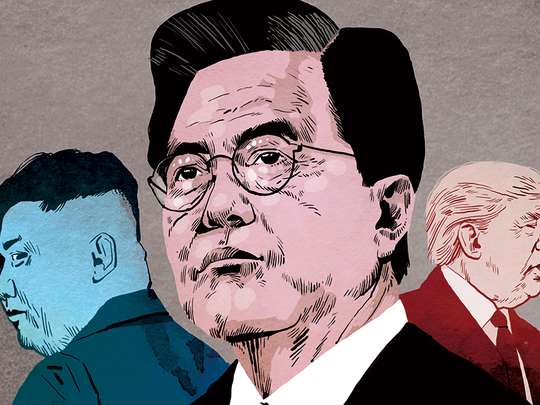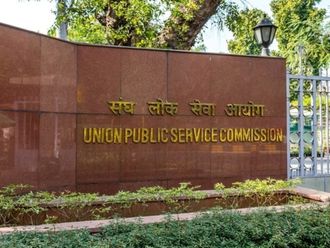
The last time his liberal political party was in power, Moon Jae-in saw his boss at the time, Roh Moo-hyun, then South Korea’s president, walk across the Demilitarised Zone into North Korea for a summit meeting that resulted in a peace declaration and promises of abundant aid.
He then saw those deals discarded a year later, in 2008, by a newly elected president who sought closer ties with President George W. Bush, who had branded the North part of an “axis of evil.” Now, as president of South Korea, Moon is keen not to repeat past failures as he stakes his own political career on brokering a deal between the unpredictable leaders of the US, his nation’s protector, and North Korea, long its mortal foe.
As chief of staff during the Roh administration, from 2003 to 2008, Moon did not participate in the negotiations with the North, led at the time by Kim Jong-il, the father of the current leader, or join Roh’s overland visit to Pyongyang, the North Korean capital. But he did help Roh organise those talks, held in October 2007. He has clearly taken to heart what he sees as the lessons of that stillborn peace initiative. One lesson was that advancing inter-Korean relations with generous offers of aid was a non-starter so long as the US remained locked in a standoff with the North over its nuclear weapons programme.
Another was that any deal with North Korea must be struck and carried out early in the terms of the South Korean and US presidents. This ensures that the agreement does not die with a change of governments and political ideologies in Seoul and Washington, as the 2007 agreement and other past deals did.
“When we look back, the most important thing is speed,” Moon told the current North Korean leader, Kim Jong-un, during their meeting last week in the Demilitarised Zone, the fortified border separating the two Koreas. During that meeting, Moon urged the North Korean to move quickly to make a deal with President Donald Trump during their talks, expected later this month or next month. “We have to learn lessons from the past,” Moon told Kim.
That need for speed is apparent in the fast pace of diplomacy that appears to be leading to a first-ever summit meeting between the leaders of the United States and North Korea, who just a few months ago appeared on the brink of war.
Moon, 65, has played a key role in bringing together Trump and Kim, who now appear likely to meet at Panmunjom, the same “truce village” in the Demilitarised Zone where Moon held his talks with Kim. Such a meeting would be a triumph for Moon, who has experienced both highs and lows in his country’s relations with North Korea.
Moon was a conscripted member of an elite paratroop unit in 1976, when axe-wielding North Korean troops murdered two US Army officers while they pruned a poplar tree that blocked their view at Panmunjom. In “Operation Paul Bunyan,” Moon’s unit was sent in to finish chopping down the tree while the North Koreans stood back. Until last week, Moon’s only visit to North Korea was in 2004, when he accompanied his mother on a government-arranged reunion to see her younger sister for the first time since the Korean War. Moon himself was born in a refugee camp during the war, after his parents fled their native North Korea on board a US Navy cargo ship.
Managing Washington ties
His approach to handling the US is one of Moon’s biggest departures from his predecessor, Roh, who committed suicide in 2009 amid corruption allegations surrounding his relatives.
Moon appears to have concluded that Roh doomed his own peace deal at least in part by failing to get Bush to back it. Instead, Roh, fiery and blunt, had vowed not to “kowtow to the Americans.”
Since taking office last year, Moon has shown himself more sophisticated and accommodating in managing relations with Washington.
He has closely consulted with the White House during the current rush of diplomacy. Moon has also been careful in public to credit Trump for making the current breakthroughs possible, saying that he deserves a Nobel Peace Prize.The need to bring in America also reflects hard-earned domestic political lessons. Moon saw Roh and Kim Dae-Jung, the two presidents who championed what was called the Sunshine Policy of engagement with North Korea, fail as the North persisted in its weapons programmes despite generous aid.
Both died heart-broken men, with their legacy dismantled by their conservative foes, who ridiculed them as naive and pro-North Korean.
“One thing South Korea has learnt is that it cannot improve ties with North Korea without progress in denuclearising North Korea,” said Kim Yong-hyun, a professor of North Korean studies at Dongguk University in Seoul. Otherwise, he said, any deal “would be like building a house of cards.” During his meeting with Kim at Panmunjom, Moon’s highest priority appeared to be convincing the young North Korean dictator that he could create a better future by striking a deal with Washington to rebuild his country’s economy in exchange for giving up his nuclear arsenal.
Despite the spectacle of the two Korean leaders leisurely holding hands as they stepped across their nations’ border, Moon and his aides compared his mission to “walking on this ice,” and urged Kim to quickly sign and implement a deal while he and Trump were in office. So far, Moon’s gambit seems to be winning broad support within South Korea.
— Choe Sang-hun is a Pulitzer Prize-winning South Korean journalist.








